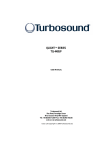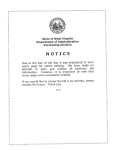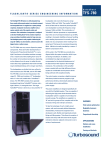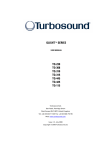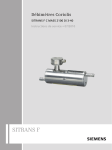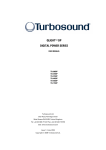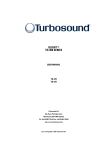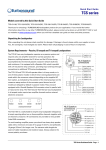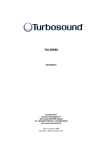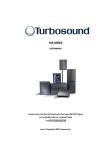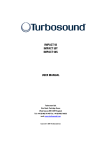Download Turbosound TQ-440 Portable Speaker User Manual
Transcript
QLIGHT SERIES TQ-440 USER MANUAL Turbosound Ltd. Star Road, Partridge Green West Sussex RH13 8RY England Tel: +44 (0)1403 711447 Fax: +44 (0)1403 710155 web: www.turbosound.com Issue 1.0 Copyright 2000 Turbosound Ltd. user manual QLight series 19/12/2002 9:57 AMCONTENTS Thanks................................................................................................................................................ 3 Unpacking .......................................................................................................................................... 3 Introduction ....................................................................................................................................... 4 Features ............................................................................................................................................. 4 Product Summary ............................................................................................................................. 5 System Requirements....................................................................................................................... 6 Amplifier Considerations .................................................................................................................. 6 Equalisation ....................................................................................................................................... 7 Dispersion .......................................................................................................................................... 7 Mounting and fixing.......................................................................................................................... 8 Arraying ........................................................................................................................................... 12 Choosing the best location ............................................................................................................. 13 Maintenance .................................................................................................................................... 14 Appendix A: Technical Specifications ............................................................................................ 16 Appendix B: Spares and Accessories............................................................................................. 17 Appendix C: Warranty..................................................................................................................... 18 TQ-440 manual page 2 user manual QLight series Thanks Thank you for choosing a TURBOSOUND TQ-440 loudspeaker product for your application. Please spare a little time to digest the contents of this manual, so that you can obtain the best possible performance from this unit. All TURBOSOUND products are carefully engineered for world class performance and reliability. If you would like further information about this or any other TURBOSOUND product, please contact us. Detailed product information is available on our web site at www.turbosound.com. We look forward to helping you in the near future. Unpacking the TQ-440 loudspeaker After unpacking the unit please check carefully for damage. If damage is found, please notify the carrier concerned at once. You, the consignee, must instigate any claim. Please retain all packaging in case of future re-shipment. TQ-440 manual page 3 user manual QLight series Introduction Congratulations, you have just purchased a professional loudspeaker system from the renowned Turbosound range, designed to give you the best in audio quality and many years of reliable, trouble free operation. It offers superior audio quality, unsurpassed vocal projection, full technical documentation including EASE data, and comprehensive rigging and flying hardware options. Please read through this manual carefully before you attempt to operate the loudspeaker system. It contains valuable information enabling you to quickly and easily set up and connect the loudspeakers, important system and set-up checks together with positioning and mounting instructions. Features ♦ Superb audio quality quality: carefully designed and matched loudspeaker drive units are used throughout to give you exceptional performance and many years of reliable, trouble free operation. ♦ Controlled dispersion dispersion: the TQ-440 enclosure exhibits a tight, controlled dispersion pattern which minimises room reflections and focuses the sound pressure directed at audience areas. ♦ Three way design design: the exclusive use of cone transducers in the low and mid frequency bands guarantees a seamless low/mid crossover, greater power handling, lower distortion and minimal mechnical stress. ♦ Time aligned components components: ts the mid frequency and high frequency drive units are physically time-aligned within the enclosure to ensure perfect time arrival. ♦ Solid construction construction: all Turbosound QLight series cabinets are built from high grade birch plywood, rebated, screwed and glued together for maximum rigidity and durability. ♦ Integral rigging points: points fitted as standard, enabling use with many different types of optional flying hardware. ♦ Compact enclosure enclosure: custom designed 12”/1”dual concentric driver allows this three-way enclosure to be the equivalent size of many traditional two-way designs. TQ-440 manual page 4 user manual QLight series Product Summary The TQ-440 is a compact three-way bi-amped full range enclosure that offers uprecendented levels of audio clarity and definition. It incorporates a custom-designed co-axial 12"/1" combination LF/HF driver in an optimally tuned vented trapezoidal enclosure handling the low and high frequency bands. The critical mid-range frequencies are handled by a proprietary 6.5" cone transducer on a 60° horizontal by 40° vertical nominal dispersion waveguide, loaded with a TurboMid device. The exclusive use of cone transducers in both the low and mid frequency bands produces a seamless transition at the crossover frequency, with the result that all of the critical vocal range right up to 8kHz is lower in distortion than compression driver-based designs. In addition the 6.5" mid-range driver is a highly efficient device, and is able to handle large amounts of amplifier power. The remaining high frequencies above 8kHz are effortlessly handled by a 1" compression driver, operating in a relatively narrow pass band, and therefore subjected to minimal mechanical stress. The mid and high components are physically time aligned within the enclosure, ensuring perfect time arrival at the listener's ear. When compared to conventional two-way designs the TQ440 is able to offer higher SPL, significantly lower distortion, and unsurpassed vocal projection capabilities in an equivalently sized physical package. The TQ-440 is designed for use with the LMS-D6 digital loudspeaket management system, which provides model-specific crossover and limiting functions. The TQ-440 is a full range loudspeaker, and used by itself will provide high quality audio for all speech and many music reproduction applications. In order to extend the effective bass frequency range of the loudspeaker by a further octave the use of the complementary TQ-425 subwoofer is recommended. TQ-440 manual page 5 user manual QLight series System Requirements The TQ-440 is a bi-amped loudspeaker system. It requires two independent amplifier channels: one channel to power the low frequency driver (LF) plus another channel to power the midrange (MF) and high frequency (HF) together. A frequency dividing network is also required to split the signal and feed it to the appropriate driver section; the LMS-D6 digital loudspeaker management system or the LMS-A6 loudspeaker management system is recommended for this purpose. Amplifier considerations The TQ-440 should be driven by high quality power amplifiers designed for true professional use. Such amplifiers will have balanced inputs, DC and RF fault protection, and well designed cooling systems for reliability. The program power listed in the loudspeaker’s technical specification is the best guide to the size of amplifier required for general purpose applications. The amplifier should therefore be capable of delivering long term broadband power equal to the loudspeaker’s program power rating at the loudspeaker’s stated nominal impedance. This approach allows sufficient headroom to generate good dynamic range. RECOMMENDED AMPLIFIER POWER RATINGS: The amplifier's rated r.m.s. continuous power output (20Hz – 20kHz, per channel) should be equal to the recommended program power handling of the loudspeaker at its nominal impedance. In general, the more powerful the amplifier the better it will sound, provided that it is not driven into sustained clipping. It should be understood that overdriving an insufficiently powered amplifier is more likely to cause loudspeaker damage – the total energy in a heavily clipped signal is far higher than in an unclipped signal – than operating a more powerful amplifier within its ratings. One controller can be used to feed several amplifiers as long as all the amplifiers are the same (or have the same gain ratings). More than one controller may be required if the amplifiers are of different gain or type. Please contact your dealer if you require help in this area. TQ-440 manual page 6 user manual QLight series Equalisation Because the TQ-440 features a smooth and even frequency response, it does not need equalisation or correction to overcome the deficiencies often found in lesser designs. Should extended frequency response be required at more than medium sound pressure levels, the use of the complementary TQ-425 subwoofer is strongly recommended. In order to to compensate for the room acoustics, the TQ-440 requires only minimal equalisation. As in any system, over-equalisation introduces phase shifts, distortion and a reduction in headroom, usually causing more problems than it cures. Under most circumstances a 1/3 or 1/2 octave graphic equaliser will generally be adequate, with the fader settings applied smoothly and as little as possible for the required room compensation. Most rooms will have resonances that will be excited at particular frequencies needing some cut to help tame the sound, these problems are most pronounced at the lower frequencies where speakers generally exhibit very little directional control. If you find that the system needs a lot of boost at lower frequencies you may need additional subbass units. It is good practice to use as little equalisation as possible, aiming to cut frequencies rather than adding large amounts of boost. Dispersion One of the design features of the TQ-440 is its tightly controlled 60º horizontal by 40º vertical nominal dispersion pattern at mid and high frequencies. This gives many user advantages and eases placement decisions, being essentially a point and shoot system. A 60º horizontal polar pattern equals an angle of 30º either side of the centre line at which the sound pressure level is 6 dB down with respect to centre, (averaged over the whole frequency range of the loudspeaker). Thus a 40º vertical dispersion gives an angle of 20º above and below the horizon. TQ-440 manual page 7 user manual QLight series Mounting and Fixing A versatile range of mounting hardware is available for the TQ-440 that allows it to be used in a variety of ways, in either mobile applications or permanent installations. A top hat stand type fitting is mounted in the base of the cabinet for use with 35mm diameter loudspeaker stands with a load rating of at least 37kgs (82lbs). This top hat fitting may also be used to mount the TQ-440 cabinet at the correct height above the complementary TQ-425 subwoofer using a straight 35mm pole. Internal metric threaded rigging points are provided in several locations on the cabinet – on the top, bottom and sides - enabling it to be flown using standard M10 shoulder eyebolts (available from Turbosound). Downward inclination of the enclosure can be adjusted using an additional rigging point on the rear of the cabinet. SideSide-mounted flying strips can be fitted to the sides of the enclosure by removing the countersunk bolts on the top and sides of the cabinet and replacing them with the M10 bolts provided with the hardware. Two FF-440 flying strips are required for each enclosure. This method offers a simple and cost effective method of flying single or multiple TQ-440 enclosures, with the load being taken through the steel strips rather than through the woodwork of the enclosure. Enclosures may be arranged in a vertical column by coupling the flying strips together using QL-75 quicklinks or shackles. TQ-440 manual page 8 user manual QLight series The universal FBFB-12 flybar assembly enables the use of several different fixing methods, all shown in the diagram here. The flybar is attached to to the cabinet using a pair of captive M10 shoulder eyebolts (supplied). There are 12 attachment points equally spaced along the length of the spine. Depending on which point is chosen for the given attachment system, a wide range of downward inclination can be achieved over a range of approximately 70 degrees. The design of the flybar even allows for upwards angles, for example for coverage of balconies that are higher than the loudspeaker location. The FB-12 flybar assembly comes supplied with a UU-6 Unilock which provides a single attachment point. The point at which the Unilock is attached to the flybar determines the vertical angle of the loudspeaker as shown in the table following. A pickpick-up point adaptor offers a further single attachment point. This option provides fast adjustment of vertical angle. The point at which the eyebolt adaptor is attached to the flybar determines the vertical angle of the loudspeaker as shown in the table following. The SCSC-440 aluminium scaffold clamp is attached to the T-bar by means of a simple clevis coupler. It is designed to rotate horizontally through 360° in order to enable accurate positioning of TQ-440 manual page 9 user manual QLight series the loudspeaker. The point at which the scaffold clamp is attached to the flybar determines the vertical angle of the loudspeaker as shown in the table following. The following table gives the predicted downward angle of the enclosure using the various attachment points on the FB-12 flybar assembly. Attachment position Vertical angle (negative angle denotes upwards) Hole number 1 (front of cabinet) -29° Hole number 2 -23° Hole number 3 -17° Hole number 4 -10° Hole number 5 -3° Hole number 6 4° Hole number 7 11° Hole number 8 18° Hole number 9 24° Hole number 10 30° Hole number 11 35° Hole number 12 (rear of cabinet) 40° The FHFH-440 is a complete flying frame and harness which enables the TQ-440 to be installed with the maximum of security. It provides unlimited variation of horizontal and vertical inclination, and is very easy to reposition and angle once rigged. TQ-440 manual page 10 user manual QLight series Modular flybar assembly The key element in flying multiple TQ-440 enclosures is a versatile Flying Bar Assembly (FB-58), manufactured by Turbosound, that will support a vertical column of up to three enclosures deep. Fly bars can be linked in the horizontal plane using the index pins provided to form arched arrays with adjustable (horizontal) angles from 0º to 45º at 5º increments per cabinet. This allows arrays and clusters of almost any angle to be configured with the ability to change array angles without dismantling and whilst suspended. This useful feature allows for fine tuning of speaker positions for best coverage, throw and SPL’s. On each side of the TQ-440 cabinet you will find keyhole type quick-release flying plates, plus top and bottom rear brackets for pull-up straps and linking plates. When flying more than one cabinet in the vertical plane speakers are suspended on fixed length steel cables (FS-60) and pull up straps (TS-440) to align the downward angles. Any installation, whether temporary or permanent, must be securely attached to the structure of the building using chain, steel wires or web straps which are certified and load rated for the purpose. The combined weight of the sound system, its cables and the rigging system must be safely carried by the points at which attachment is made to the building or structure. Great care must be taken in selecting the attachment points and methods, being absolutely sure of the load carrying capacity of points chosen. NOTE: The rigging of loudspeaker systems is an extremely serious matter with potentially lethal consequences should anything go wrong. It is of vital importance that you, or other people rigging the system, are suitably qualified to do so and have a full understanding of all the factors involved with safety as a number one priority. Turbosound accept no responsibility for any accident, damage or failure of any rigged system. This rigging information is specifically related to the requirements of the TQ-440 series only. For more detailed information on the whole topic of rigging various handbooks are available. If you are in any doubt contact your Turbosound dealer who will be able to refer you to an experienced rigging company. TQ-440 manual page 11 user manual QLight series Arraying The TQ-440 has a side-wall angle of 16º. Use this position for smooth horizontal dispersion that is ideal for many applications. With the high dynamic range capability and low power compression of the TQ-440 you should find this wide angle arrangement adequate for all but the most demanding long throw requirements. It also has the advantage of needing fewer cabinets to cover the required area. When speakers are mounted together in close proximity either stacked on top of each other or arrayed the output increases due to the coupling effect. For instance, stacking two cabinets on top of each other with the top one inverted gives around 4.5 dB increase in the mid/high section, ideal for long throw in large halls, sports stadiums, etc. Mounting the bass drivers close to each other gives the same gain at the low end. When the system is arrayed for wider angle coverage with cabinets side by side the gain is in the order of 3db. TQ-440 manual page 12 user manual QLight series Choosing the best location It was stated earlier that the TQ-440’s tightly controlled directivity gives it essentially point and shoot qualities. Every room has its own unique set of characteristics that affect any sound introduced into the room. These include reverberation reflections and decay time, sound absorption of materials used, temperature and humidity, etc. A degree of experimentation with different locations (if possible) is best, especially if you are permanently installing the speaker and have particular requirements where you want to concentrate the sound into a specific area. Any boundary like a wall or floor will lift certain frequencies. If you are fixing the unit to a wall, or in a corner then a lift at the bass end is to be expected and it may sound rather boomy. Either reduce the low end by means of a graphic equaliser or move the speaker. Rooms with a lot of soft furnishings, curtains and drapes will absorb sound, especially at high frequencies. These rooms can sound rather dead and may appear to need more amplifier power to generate high SPL’s but have the advantage that the sound needs less equalisation and is easier to control. In this case the listener receives mainly direct sound, that is the sound emanating directly from the loudspeaker, with little reflected sound. If the room has a lot of hard, exposed surfaces such as wooden floors, brick or plaster walls or glass windows, these will reflect the sound, causing it to bounce around the room and sounding over bright. These rooms also tend to have various resonances that will be excited by high SPL’s. Listening in the middle of the room you will hear a lot of reflected sound in comparison with the direct sound. Care is needed with speaker positioning, SPL’s and equalisation. If the room is large and very reverberant then bass roll-off below about 250 Hz may be required to ensure a reasonable level of intelligibility. For long, narrow rooms the traditional left and right stacks (floor, wall mounted or flown) can suffice with good stereo imaging in the centre of the room. For multi-tier venues such as theatres, speakers should be flown or wall mounted to project into each tier. In highly reverberant rooms often a central cluster is the best option. This acts as a virtual point source with all the sound emanating from one point in the room, but path lengths should be carefully calculated. The relationship between sound pressure level and distance is an “inverse square law” so remember that every time the distance from the sound source is doubled the sound level decreases by 6dB. For every 3dB increase of speaker output you need a doubling of input power and you can work out the Wattage input needed to give the required SPL levels at various distances from the loudspeaker(s). When speakers are flown in free space then boundary effects are minimised. The result is a smooth frequency response without any boost at odd frequencies, but the bass end may appear subjectively light. In this case you will need floor mounted sub-bass, to bring the low end up. TQ-440 manual page 13 user manual QLight series Maintenance If one of the drive units in the cabinet should cease functioning and needs a replacement recone or diaphragm you are advised to remove the faulty unit from the cabinet and send it to a professional recone service authorised to recone Turbosound loudspeakers. This will ensure the continued high performance of your TQ-440. Removal of the 12”/1” driver 1. Unscrew the eight countersunk screws from the two vertical battens which hold the protective grille in place. Be careful when removing the grille as it is under tension and may spring outwards when released. Set the battens, grille and fixing screws aside for later re-assembly. 2. Undo the eight M6 x 30mm Allen head bolts holding the driver in place and carefully pull it out and away from the cabinet. WARNING - This unit is heavy! You will notice that the 1” high frequency driver is attached to the back of the 12” low frequency driver by its screw adapter. Disconnect the cables from both HF and LF units and completely remove the driver assembly from the cabinet. Make a note of the driver polarity for later reconnection. 3. Separate the drive units by unscrewing the high frequency driver anti-clockwise and lift it away from the low frequency driver. Depending on which section needs servicing, the appropriate drive unit should be returned to an authorised Turbosound service centre. 4. To reinstate the drivers, simply reverse the above procedure making sure you observe the correct polarity when reconnecting the cables back into the terminals of the drive units. Removal of the midrange drive unit If the midrange drive unit requires maintenance, it will first be necessary to remove the rear panel. The midrange driver is held in place by a M10 x 25mm bolt through the rear of the cabinet into the back plate of the drive unit behind the rear panel. Once this is released the midrange horn and drive unit assembly can be removed. 1. Remove the #10 x 1 ½” countersunk woodscrews securing the rear panel of the cabinet. The M10 bolt securing the midrange driver will now be accessible in a recess in the enclosure rear panel. Using a 17mm socket, unscrew the bolt and set aside for later re-assembly. 2. Unscrew the eight countersunk screws from the two vertical battens which hold the protective grille in place. Be careful when removing the grille as it is under tension and may spring outwards when released. Set the battens, grille and fixing screws aside for later re-assembly. TQ-440 manual page 14 user manual QLight series 3. The midrange horn is secured through the mounting flange with four #10 x 1/12” pan head wood screws. Unscrew these and lift out the horn and driver assembly. 4. Disconnect the cables, making a note of the polarity, and carefully lift the driver clear. For any other servicing requirements please contact your Turbosound dealer or authorised service centre. TQ-440 manual page 15 user manual QLight series APPENDIX A Technical Specifications Dimensions 558mm x 409mm x 363mm (23.1” x 16.1” x 14.3”) Net weight 30kgs (66lbs) Components 12”/1” LF/HF dual concentric driver, 6.5” MF driver on a TurboMid device Frequency response 75Hz – 20kHz ±4dB (with LMS-D6) Nominal dispersion 60°H x 40°V @-6dB points Power handling LF: 300 watts r.m.s., 600 watts program, 750 watts peak MF/HF: 150 watts r.m.s., 300 watts program, 375 watts peak Sensitivity LF: 103dB, 1 watt @ 1 metre; MF/HF: 104dB, 1 watt @ 1 metre Maximum SPL 131dB continuous, 137dB peak Crossover Active LF/MF: 1k3Hz, 24dB/octave slope, Linkwitz-Riley Internal passive crossover at 8kHz, double fourth order high pass Construction 15mm (5/8”) birch plywood throughout; rebated, screwed and glued. Finished in black semi-matt textured paint. Two recessed carrying handles. Integral 35mm pole mount. Two keyhole flyplates Grille Reticulated foam on expanded steel mesh Connectors (2) Neutrik Speakon NL4MP wired pin 1+ LF positive, pin 1- LF negative pin 2+ MF/HF positive, pin 2- MF/HF negative Options TurboBlue semi-matt textured paint Due to continuing product improvement the above specifications are subject to change. TQ-440 manual page 16 user manual QLight series APPENDIX B Spares and accessories LS-1214 12” (305mm) LF loudspeaker RC-1214 Recone kit for LS-1214 LS-6505 6.5” (165mm) MF loudspeaker RC-6505 Recone kit for LS-6505 CD-103 1” (25mm) HF compression driver RD-103 Replacement diaphragm for CD-103 PX-440BI Internal passive crossover network MG-440 Replacement foam / metal grille Flying accessories EB-10 M10 shoulder eyebolt FF-440 Flying strips (2 required per enclosure) FB-12 Universal fly bar assembly PP-440 Pick-up point adaptor U-6 Unilock SC-440 Scaffold clamp FB-58 Modular fly bar assembly FS-60 Flying steel TS-440 Tilt strap BS-440 Biscuit FH-440 Flying frame and harness TQ-440 manual page 17 user manual QLight series APPENDIX C: WARRANTY Limited Warranty This Turbosound loudspeaker product is warranted to the original end-user purchaser and all subsequent owners for a period of two (2) years from the original date of purchase. Warranty Coverage Warranty coverage includes defects in materials and workmanship. It does not include: ♦ damage caused by accident, misuse, abuse, neglect or modification by any person other than an authorised Turbosound representative, ♦ damage caused by overdriving, use with unsuitable amplifiers or amplifier failure, ♦ damage caused by failure to operate the product in accordance with the instructions contained in the user manual, ♦ damage occuring during shipment in transit, ♦ claims based on any misrepresentation by the seller, ♦ products which do not have the original components as specified in the product engineering information, ♦ products on which the serial number has been removed or defaced. Shipping Should any fault develop with a component of your Turbosound system, please return the product, freight pre-paid, in its original packing carton, along with proof of purchase such as the original bill of sale or receipted invoice, and a description of the suspected fault to Turbosound Ltd. (Att: Customer Service), Star Road, Partridge Green, West Sussex RH13 8RY, England, or your local authorised Turbosound representative. The product serial number must be quoted in all correspondence relating to the claim. Insurance is recommended, as Turbosound or its representatives are not liable for loss or damage in transit. Turbosound will pay for return freight costs should repairs be covered under warranty. TQ-440 manual page 18 user manual QLight series Incidental and consequential damages Turbosound's liability is limited to the repair or replacement, at our option, of any defective product, and shall not be liable for any incidental and consequential damages including, without limitation, injury to persons or property or loss of use. Limitation of implied warranties All implied warranties, including warranties of merchantability and fitness for a particular purpose, are limited in duration to the length of this warranty. This warranty is in addition to, and in no way detracts from, your statutory rights as a consumer. No other warranty is expressed or implied. Please record your purchase information below for future reference: Dealer Name ...................................................................................................................... Dealer Address .................................................................................................................. ............................................................................................................................................ ............................................................................................................................................ Post / Zip Code .................................................................................................................. Dealer telephone / fax ....................................................................................................... Invoice number ................................................................................................................. Date of purchase ............................................................................................................... Unit serial number ............................................................................................................ TQ-440 manual page 19 Turbosound Ltd. Star Road, Partridge Green West Sussex RH13 8RY England Tel: +44 (0)1403 711447 Fax: +44 (0)1403 710155 web: www.turbosound.com





















